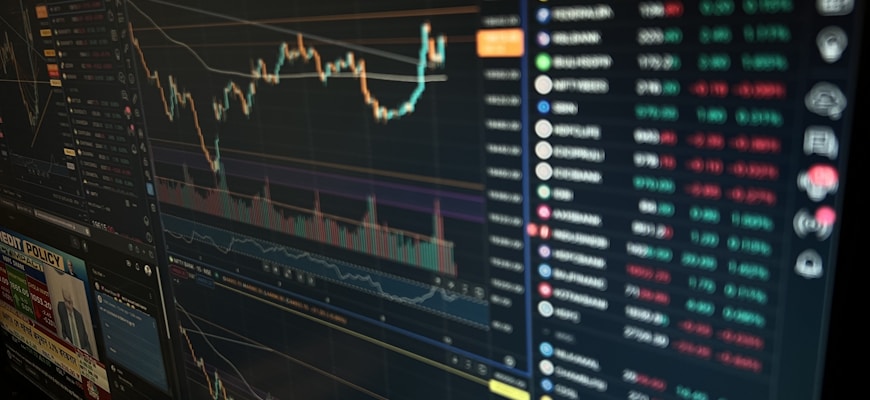Insights from a Crypto Trader: Strategies for Navigating Volatility

- Understanding Market Volatility in Cryptocurrency Trading
- Risk Management Techniques for Crypto Traders
- Analyzing Trends to Make Informed Trading Decisions
- The Role of Emotional Intelligence in Navigating Crypto Volatility
- Implementing Stop-Loss Orders for Risk Mitigation
- Strategies for Profitable Trading in a Volatile Crypto Market
Understanding Market Volatility in Cryptocurrency Trading
Understanding market volatility in cryptocurrency trading is essential for any trader looking to navigate this fast-paced and often unpredictable market. Volatility refers to the degree of variation of a trading price series over time. In the world of cryptocurrency, prices can fluctuate dramatically within short periods, presenting both opportunities and risks for traders.
There are several factors that contribute to volatility in cryptocurrency markets. These include market demand, regulatory developments, technological advancements, and macroeconomic trends. By understanding these factors and how they impact prices, traders can better anticipate market movements and make informed decisions.
One key strategy for navigating volatility in cryptocurrency trading is diversification. By spreading investments across different cryptocurrencies, traders can reduce their risk exposure to any single asset. Diversification can help protect against major losses and increase the chances of profiting from market upswings.
Another important strategy is setting stop-loss orders. These orders automatically sell a cryptocurrency when its price falls to a certain level, helping traders limit their losses in case of a sudden market downturn. By setting stop-loss orders, traders can protect their investments and mitigate the impact of volatility.
Overall, understanding market volatility in cryptocurrency trading is crucial for success in this dynamic market. By staying informed about market trends, diversifying investments, and using risk management tools like stop-loss orders, traders can navigate volatility effectively and maximize their chances of success.
Risk Management Techniques for Crypto Traders
One of the key aspects of successful crypto trading is effective risk management. Cryptocurrency markets are highly volatile, and as such, traders must employ various techniques to mitigate potential losses. Here are some strategies that crypto traders can use to navigate market volatility:
| 1. Diversification: | By spreading investments across different cryptocurrencies, traders can reduce the risk of significant losses if one asset underperforms. |
| 2. Stop-loss Orders: | Setting stop-loss orders can help traders automatically sell a cryptocurrency once it reaches a certain price, limiting potential losses. |
| 3. Position Sizing: | Calculating the appropriate position size based on risk tolerance and overall portfolio size can help traders manage risk effectively. |
| 4. Risk-Reward Ratio: | By assessing the potential reward against the risk of a trade, traders can make more informed decisions and avoid excessively risky trades. |
Implementing these risk management techniques can help crypto traders navigate the ups and downs of the market while protecting their capital. By diversifying their portfolios, using stop-loss orders, sizing positions appropriately, and evaluating risk-reward ratios, traders can increase their chances of success in the volatile world of cryptocurrency trading.
Analyzing Trends to Make Informed Trading Decisions
Analyzing trends is crucial when it comes to making informed trading decisions in the volatile world of cryptocurrency. By studying historical data and identifying patterns, traders can gain valuable insights into the market and anticipate potential price movements. This information allows them to buy or sell assets at the right time, maximizing profits and minimizing risks.
One effective strategy for analyzing trends is to use technical analysis tools, such as moving averages, relative strength index (RSI), and Fibonacci retracement levels. These tools help traders identify key support and resistance levels, as well as potential entry and exit points for trades. By combining technical analysis with fundamental analysis, which involves evaluating the underlying factors driving market movements, traders can make more informed decisions about when to enter or exit positions.
It’s also important to stay up-to-date with the latest news and developments in the cryptocurrency industry. Market sentiment can be heavily influenced by external factors, such as regulatory announcements, technological advancements, or macroeconomic trends. By staying informed, traders can better understand the market dynamics and adjust their strategies accordingly.
In conclusion, analyzing trends is a critical aspect of successful trading in the cryptocurrency market. By utilizing technical and fundamental analysis tools, as well as staying informed about industry news, traders can make more informed decisions and navigate volatility with confidence.
The Role of Emotional Intelligence in Navigating Crypto Volatility
Emotional intelligence plays a crucial role in navigating the volatility of the crypto market. Being able to manage emotions such as fear, greed, and anxiety can help traders make rational decisions in the face of price fluctuations.
By developing a high level of emotional intelligence, traders can avoid making impulsive decisions based on short-term market movements. Instead, they can take a more strategic approach to their trading, focusing on long-term goals and objectives.
Traders with high emotional intelligence are better able to handle the stress and pressure that comes with trading in a volatile market. They can remain calm and composed, even when facing significant losses or unexpected gains.
Furthermore, emotional intelligence can help traders build stronger relationships with other market participants. By understanding and empathizing with the emotions of others, traders can collaborate more effectively and make better-informed decisions.
In conclusion, emotional intelligence is a valuable asset for crypto traders looking to navigate the ups and downs of the market. By developing this skill set, traders can improve their decision-making abilities, build stronger relationships, and ultimately achieve greater success in their trading endeavors.
Implementing Stop-Loss Orders for Risk Mitigation
One effective strategy for managing risk in the volatile world of cryptocurrency trading is implementing stop-loss orders. A stop-loss order is an instruction given to a broker to sell a security when it reaches a certain price, designed to limit an investor’s loss on a position in a security. By setting up stop-loss orders, traders can protect themselves from significant losses in case the market moves against their positions.
Stop-loss orders are a crucial tool for risk mitigation in the crypto market, where prices can experience rapid and unpredictable fluctuations. By defining a specific price at which a trade will be automatically closed, traders can ensure that they do not suffer excessive losses in case the market turns against them. This automated approach to risk management can help traders stay disciplined and avoid emotional decision-making in the heat of market volatility.
When setting up stop-loss orders, traders should consider the level of volatility in the market, as well as their risk tolerance and investment goals. It is essential to strike a balance between setting a stop-loss order too tight, which may result in premature exits from trades, and setting it too loose, which may expose traders to significant losses. Traders should also regularly review and adjust their stop-loss orders to reflect changes in market conditions and their trading strategies.
In conclusion, implementing stop-loss orders is a valuable strategy for navigating the volatility of the cryptocurrency market. By defining clear exit points for trades, traders can protect their capital and manage their risk effectively. It is essential for traders to understand how stop-loss orders work and to incorporate them into their trading strategies to improve their chances of success in the challenging world of cryptocurrency trading.
Strategies for Profitable Trading in a Volatile Crypto Market
When trading in a volatile crypto market, it is crucial to have a clear strategy in place to maximize profitability and minimize risks. Here are some key strategies to consider:
- Diversification: Spread your investments across different cryptocurrencies to reduce the impact of price fluctuations on any single asset.
- Stop-loss orders: Set stop-loss orders to automatically sell a cryptocurrency if its price falls below a certain level, helping to limit potential losses.
- Take-profit orders: Similarly, use take-profit orders to lock in profits when a cryptocurrency reaches a certain price level, helping to capitalize on price increases.
- Stay informed: Keep up to date with market news, trends, and developments to make informed trading decisions based on the latest information.
- Emotional control: Avoid making impulsive decisions driven by fear or greed, as these can lead to poor trading outcomes in a volatile market.
By implementing these strategies and staying disciplined in your approach, you can navigate the ups and downs of a volatile crypto market more effectively and increase your chances of successful trading.




